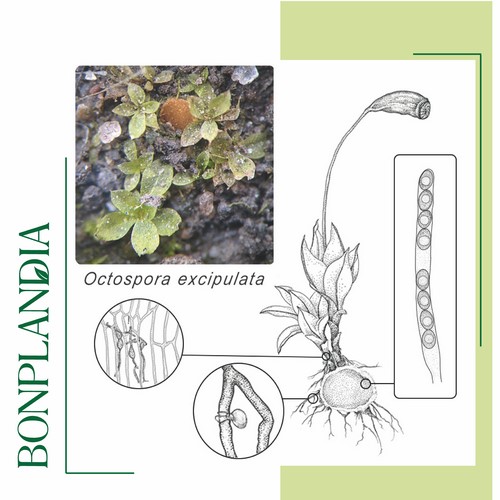Discovery of Octospora excipulata (Pezizales) in South America
DOI:
https://doi.org/10.30972/bon.3417990Palavras-chave:
Argentina, bryoparasitic Pezizales, Funaria, Funariaceae, Pyronemataceae, YungasResumo
The bryophilous ascomycete Octospora excipulata (Clem.) Benkert is reported as a new record in South America, based on samples collected in Tucumán, Argentina. The species was observed infecting the American moss Funaria calvescens (Funariaceae). This study provides a concise description and illustrations highlighting both macroscopic and microscopic characteristics of the species. Additionally, comments on the host identity are included.
Downloads
Referências
Benkert, D. (2008) [2007]. Zur Kenntnis des Vorkommens bryophiler Pezizales (Ascomycota) in Südost-Europa. Mycologia Montenegrina 10: 7-21.
Delgadillo-Moya, C., Escolástico, D. A., Hernández-Rodríguez, E., Herrera-Paniagua, P., Peña-Retes, P. & Juárez-Martínez, C. (2022). Manual de Briofitas. 3ra ed. Universidad Nacional Autónoma de México, México.
Dias, M. S., Fernandes Peralta, D. & Da Silva Neto, S. J. (2018). Taxonomic treatment of the Funariaceae from Brazil. Phytotaxa 357: 77-93. https://doi.org/10.11646/phytotaxa.357.2.1
Eckstein, J. (2016). Key to main groups of bryoparasitic Pezizales. http://www.octospora.de/identification. htm (Accessed: 15/07/2024).
Eckstein, J. (2024). Bryoparasitic Pezizales. http:// www.octospora.de (Accessed: 15/07/2024)
Frahm, J. P., Pócs, T., O ́Shea, B. Koponen, T., Piippo, S., Enroth, J., Rao, P. & Fang, Y. M. (2003). Manual of Tropical Bryology. Board, Germany. https://doi.org/10.11646/bde.23.1.1
Gamundí, I. J. (1960). Discomycetes operculados de la Argentina familias Pezizaceae y Humariaceae. Lilloa 30: 296-338.
Gamundí, I. J. (1973). Discomycetes de Tierra del Fuego II. Especies nuevas de Humariaceae. Boletín de la Sociedad Argentina de Botánica 15: 85-92.
Gamundí, I. J., Minter, D. W., Romero, A. I., Barrera, V. A., Giaiotti, L. A., Messuti, M. I. & Stecconi, M. (2004). Checklist of the discomycetes (Fungi) of Patagonia, Tierra del Fuego and adjacent Antarctic areas. Darwiniana 42: 63-164. https://doi.org/10.14522/darwiniana.2014.421-4.155
Janošík, L., Sochorová, Z., Eckstein, J., Vega, M. & Koukol, O. (2022). Ascospore morphology of bryophilous Pezizales is closely associated with the place of infection and host ecology. Fungal Ecology 61: 101200. https://doi.org/10.1016/j. funeco.2022.101200
Jukić, N., Tomić, S., Sabovljević, M. & Omerović, N. (2018). Notes on some bryophilous Pezizales (fungi) in the Mediterranean part of Bosnia and Herzegovina. Glasnik Šumarskogfakulteta Univerziteta u Banjoj Luci 28: 71-83. https://doi.org/10.17110/StudBot.2017.48.1.105
Németh, C. (2017). Octospora erzbergeri (Pyronemataceae), a bryophilous ascomycete in Hungary. Studia Botanica Hungarica 48: 105-123. https://doi.org/10.17110/StudBot.2017.48.1.105
Németh, C., Vega, M., Hernanz, J., Eckstein, J. & Janošík L. (2023). Octospora entosthodontophila, a new smoothspored bryophilous ascomycete on Entosthodon spp. Herzogia 36: 283-304. https://doi.org/10.13158/ heia.36.2.2023.283
Ochi, H. (1968). A revision of the family Funariaceae (Musci) in Japan and the adjacent regions. Japanese Journal of Botany 20: 1-34.
Sharp, A. J., Crum, H. A. & Eckel, P. M. (eds). (1994). The Moss Flora of Mexico. Memoirs of the New York Botanical Garden 69: 1-1113.
Suárez, G. M., Dominguez, F. G., Pajot, H., Flores, J. R. & Catania, M. (2023). Octospora tucumanensis (Pezizales), a new bryophilous ascomycete on Dimerodontium balansae (Bryophyta) from Argentina. Mycological Progress 22:54: 1-19. https://doi.org/10.1007/s11557-023-01909-1

Downloads
Publicado
Versões
- 2025-02-24 (3)
- 2024-12-20 (2)
- 2024-12-20 (1)
Como Citar
Edição
Seção
Licença
Copyright (c) 2024 Bonplandia

Este trabalho está licenciado sob uma licença Creative Commons Attribution 4.0 International License.
Declaration of Adhesion to Open Access
- All contents of Bonplandia journal are available online, open to all and for free, before they are printed.
Copyright Notice
- Bonplandia magazine allows authors to retain their copyright without restrictions.
- The journal is under a Creative Commons Attribution 4.0 International license.














.jpg)


